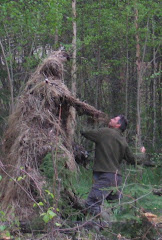(I've) been thinking much about eukaryotic evolution lately. Discovered that I left among the many important titles, Dan Dennett and so I shelled out for another copy and re-read it. This time around I found myself nearly paralyzed with the awe of representation. A common sight around the house was me in a rocking chair, book in lap staring out into space trying to come to terms with my own representation of the world. It looks so real and its hard not to think that your looking through the 'thickness of reality' as opposed to an elaborate and mysterious series of internal? representations of near perfect correspondence (from a subjective, utility perspective). Anyway, this attempt of internal phenomenology produced an overload of awe which at least has born some interesting thought fruit.
For example: I naturally began to be awed at the evolution of our brain and I got thinking that (a la Braitenberg) determining operations from behaviors is really hard and I wondered what kind of computing power would be required to make a synthetic evolutionary model? I knew that it would require a computing scale far beyond that which is attainable for decades. I wondered though how much information would have to be available to make such a model work? Which led me to the most curious question:
How much information does reality contain? in say GB/cm3 (on average)
I worked on this problem for the better part of a week and wrote about 15 pages of thought-clarifying drivel in attempting to solve the problem. Just sorting out the assumptions is quite trying. Of the many interesting sub-problems that emerged from this was the following. Lets say that we're using par example: a cup of coffee. If we try to describe the visual information and reduce it to bits we discover that volume is irrelevant since we don't experience the inside of anything (except if we pick it up in which case its density contributes to the possible experiences we can have but that forms part of the interactive data) As far as the visual world goes, all the information is a summation of surface areas. How curious that reality is 3D, we represent it 3D, and yet the information that describes it is 2D! I don't know why this intrigues me so much but it does. Anyway, after calculating the info inherent to any object plus the object -generated info (ex in different light the object appears different and therefore has info generating capacity), also considering the resolution of the eye(.12mm/.10 degree) determines the scale surface area resolution, plus the colour and hue maximum discriminations, also considering contributing information in tactile interaction both directly (temperature conductivity, texture) and indirectly, plus a bunch of other stuff, I have arrived at the following:
Reality contains on average, 200 GB/cm3 of information(as it pertains to potential human interaction, excluding man-made artifacts, at a given time T)
(what a truly absurd but cool statement!!)
Those wishing to challenge this figure are most welcome to present their own calculations and/or inquire about the methodology not included for brevity.
So the upshot of this was that if we take this number and multiply it by the size of the habitable environment and times the population of eukaryotic life over the 50 million iterations of its evolutionary history, and you've got a number that is bigger than the number of particles in the known universe. Which means that as a computational science problem, an accurate and complete model of eukaryotic evolution is impossible (of course.) Which made me appreciate the 'computing power of nature.' If we imagine evolutionary history as a design solution to a massive computational science problem, we see that problems with information scale impossibilities can be solved by using the massive information contained in things rather than the paltry information generated by virtual things. Very Douglas Adam-sish. I was then just beginning to imagine how one could take advantage of the information and complexity scale advantages of having a computer interact with hunks of stuff when the limit of the thinkable had been breached and my head shut off.
Well, that's what I was thinking about in the Penny last week. Hope anyone who waded through this will have an interesting thought or two about something or other.

Subscribe to:
Post Comments (Atom)


4 comments:
200 GB seems really high, and yet I remember that when I tried to work out how much info would be required to represent reality as it actually is visually experienced for vr, the number was astonishingly large.
And the human visual aspect is a miniscule part of the amount of info present.
hmmm. now I'm actually going to have to think about this. Guess I'm off for a pint.
=^_^=
re: rainswept's morning notion, I wasn't even attempting to encapsulate the information contained in other people. If this were added, I think we could easily raise the number by a factor of ten to the god.
The question posed by the devolved is: Qu'est'ce que c'est "chiques des chaques dans les pouch"?
Post a Comment